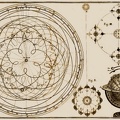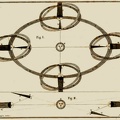34/40
Accueil / Albums / Technology / Astronomy /
The Planets, Showing their Relative Distances and Dimensions
(Drawn approximately to scale)
The isolation of the Solar System is very great. On the above scale the nearest star (at a distance of 25 trillions of miles) would be over one half mile away. The hours, days, and years are the measures of time as we use them; that is: Jupiter's "Day" (one rotation of the planet) is made in ten of our hours; Mercury's "Year" (one revolution of the planet around the Sun) is eighty-eight of our days. Mercury's "Day" and "Year" are the same. This planet turns always the same side to the Sun.
- Auteur
- The Project Gutenberg EBook of The Outline of Science, Vol. 1 (of 4), by J. Arthur Thomson
Published in 1922
Available from gutenberg.org - Ajoutée le
- Jeudi 16 Juillet 2020
- Dimensions
- 1200*322
- Tags
- Albums
- Visites
- 877
- Téléchargements
- 53
 Télécharger la photo
Télécharger la photo





